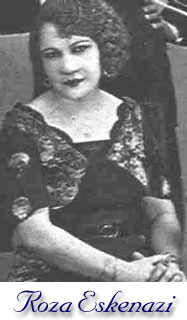 |
||
|
Q. Where can I hear rebetiko music online? A. A London student has created a site dedicated to "the fabulous women who make the rebetiko famous." It includes stories about the performers, discographies, and a useful collection of links. The most exciting feature, though, is an astonishing collection of recordings dating back to the twenties. |
||
|
The Rebetisses is a simply designed, attractive site "dedicated to the fabulous women who make the rebetiko famous." It includes stories about the performers, discographies, and a useful collection of links. The most exciting feature, though, is an astonishing collection of recordings dating back to the twenties, and featuring many of the most notable female perfomers. Legends such as Sotiria Bellou and Rosa Eskenazi are here, along with Rita Abatzi, Ioanna Yorgapolou, Stella Haskil, and many others. I experienced the proverbial chill up the spine as I heard these decades-old recordings transmitted over my PC. Visitors will need RealAudio software to listen to the songs. Created and maintained by University of London doctoral student Diane Mueller, the site began as a research project. Mueller, a rebetika scholar, noticed an absence of material on the web, especially about the women performers who have been so central to this art form. Although the site is in English, some of the resources it links to are not. |
||
 |
 |
 |
Music Of Defiance The development of rebetiko spanned one of the most turbulent periods in Greek history -- an era that included Nazi occupation and civil war. Sometimes called the "Greek blues," rebetiko is a music of defiance, and government censors studied lyrics carefully, looking for political references. Songwriters and performers, meanwhile, did their best to outwit the censors. Some artists lived daring, unconventional lives -- Sotiria Bellou, for instance, made no secret of her preference for women, and indulged in a passion for gambling. Others, such as Ioanna Yeorgakopolou, managed to raise families. All contributed to what has become one of Greece's most admired contributions to world culture. Because of a problem with the code, the RealAudio recordings cannot be accessed directly from the main menu. Instead, visitors should go to the individual artist bios, and access the song files from there. Except for this glitch, Mueller's site is user-friendly and easy to navigate. It gets good marks for overall design, and the home page features a beautiful graphic. HCS Featured Site: The Rebetisses URL: http://www.geocities.com/Athens/3124/index.html Special site for Rosa Eskenazi fans Rosa Eskenazi aficionados should check out a special page devoted entirely to this legendary diva, who has been compared to Piaf and Billie Holiday. Rosa, whose real name was Sarah Skinazi, was born into a family of Sephardic Jews in Constantinople. Much about her early life, including her exact birthdate, is unknown. Her career took off in the late 1920s, when a record producer discovered her at an open-air taverna in Piraeus. Eskenazi went on to become the highest-paid and most prolific artist of her time, specializing in Smyrnaic and Demotic songs as well as Rebetika. She was multilingual, singing in Greek, Turkish, Arabic, Italian, Armenian, and probably also Djudezmo, the language of Sephardic Greek and Turkish Jews. She continued performing until a few years before her death in 1980. Despite her fame, Rosa Eskenazi was buried in an unmarked grave near the Gulf of Corinth. Rebetiko Club Want to learn more about the history and traditions of rebetiko? Visit the Rebetiko Club, which has pages in English and Greek. It offers comprehensive information about rebetiko music, and provides a lively bulletin board. -- Robert Herschbach |
||
 |
||

